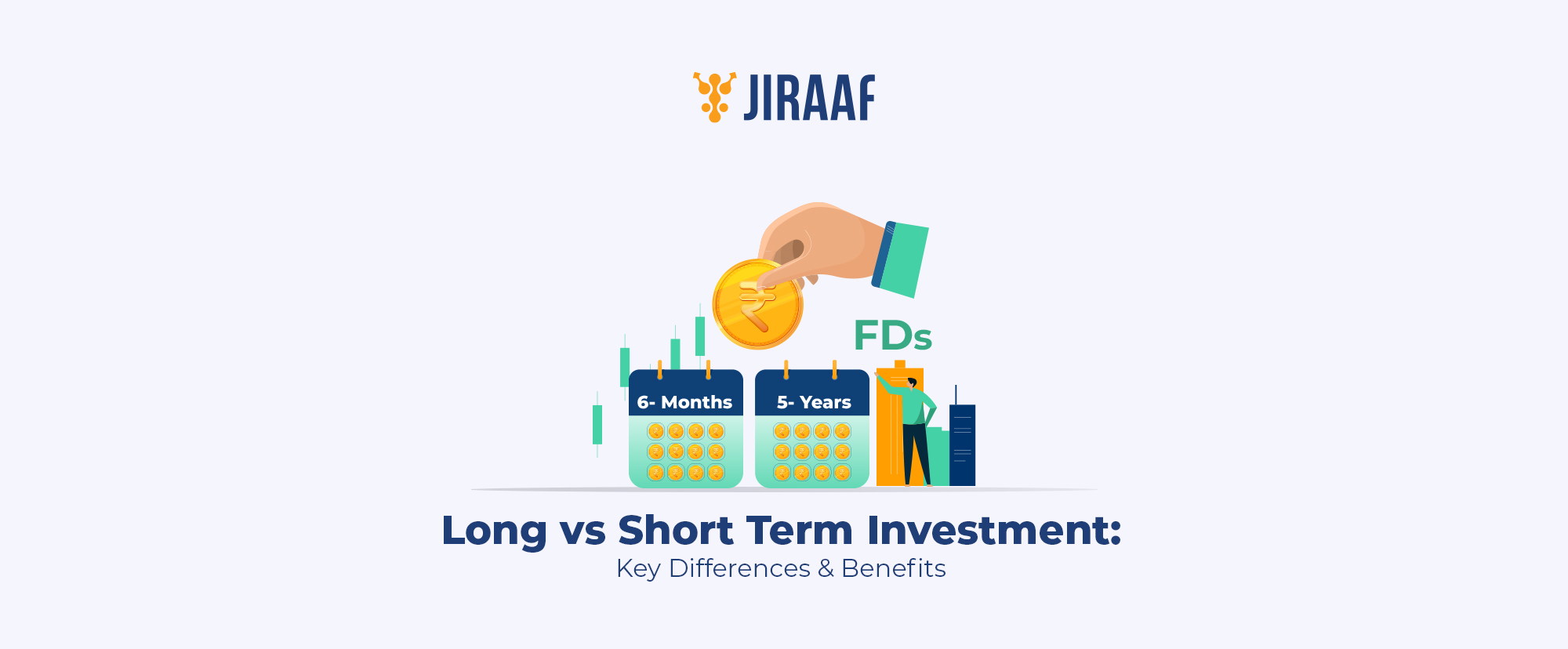Our choice of investment instruments is largely driven by the investment goal we have in mind, the horizon associated with it and the risk that come along. Broadly the investment choices can be classified as long-term and short-term investments. Each of these categories have its unique advantages and potential drawbacks, making it essential to align your investment strategy with your financial goals and risk tolerance. Let’s look at each of the two categories in detail, what they entail and how should you go about choosing them.
What is Long-term Investment?
Long-term investments are assets that an individual or a company plans to hold for an extended period, typically more than a few years. These assets are acquired with the intention of generating long-term growth or income rather than immediate returns. Common examples of long-term investments include stocks, bonds, mutual funds, FDs and real estate. They are meant for goals like retirement, children’s education etc.
Benefits of Long-term Investment
1. Compound Interest
One of the most significant advantages of long-term investing is the power of compounding it comes with. Your initial investment not only earns interest, but also over time, interest earns additional interest. For example, if you invest a sum and leave it for several years, the growth multiplies as the interest compounds. The longer your money stays invested, the more pronounced this effect becomes, making it a key factor in long-term wealth growth.
2. Tax Benefits
Long-term investments often enjoy favourable tax treatment compared to short-term trading. Gains from investments held for over a year may be taxed at a lower rate than short-term gains. Additionally, certain retirement or investment accounts offer tax-deferred or tax-free growth, allowing your money to grow without annual tax deductions. This helps you retain more of your returns, accelerating wealth accumulation.
3. Less Trading Fees
When you invest for the long term, you reduce the need to frequently buy and sell assets, which means you’ll incur less trading fees and commissions. Constantly trading stocks or other securities can lead to high transaction costs, which can eat into your profits. By sticking to a long-term strategy, you avoid these extra costs, letting your investments grow more efficiently over time.
4. Less Volatile
Long-term investments are less affected by short-term market fluctuations because they allow time for recovery and benefit from the compounding of returns. That’s one of the main reasons why people invest in SIPs. SIPs allow investors to invest a fixed amount regularly in mutual funds, regardless of market conditions. This strategy helps reduce the impact of short-term market fluctuations through rupee cost averaging, where investors buy more units when prices are low and fewer units when prices are high. Over time, this smoothens out the cost of investment, reducing the effect of volatility, and leveraging the compounding effect for long-term wealth creation.
What is Short-term Investment?
Short-term investments, also known as marketable securities or temporary investments, are financial assets that can be rapidly converted into cash, usually within a five-year period, with many being cashable within a year. These investments are designed to preserve capital while earning returns and are usually low-risk and highly liquid. Examples of short-term investments include certificates of deposit (CDs), money market accounts, high-yield savings accounts, treasury bills, and government bonds.
Other options include commercial paper, short-term corporate bonds, and cash management accounts. These investments provide flexibility and quick access to funds, making them ideal for managing short-term financial goals or immediate cash needs.
Benefits of Short-term Investment
1. Liquidity
Short-term debt securities are highly liquid, meaning they can be quickly and easily converted into cash with minimal impact on their value. This makes them an attractive option for investors who may need quick access to funds without worrying about losing a significant portion of your investment. Because these securities typically have shorter maturities, they are less vulnerable to market fluctuations, allowing investors to sell them and recover money without delay or significant loss in value.
2. Lower Risk
Short-term investments generally come with lower risk compared to long-term options. Since they are held for shorter periods, they are less exposed to market volatility and economic downturns. Additionally, many short-term debt securities, like treasury bills or high-quality corporate bonds, are issued by highly creditworthy entities, which further reduces the chance of default. This lower risk profile makes short-term debt securities a safer choice for conservative investors or investors looking to preserve capital.
3. Getting Quick Profit
Short-term investments offer the potential to generate quick profits due to their short maturity periods and regular interest payments. Investors can capitalise on opportunities to earn a modest return in a short amount of time, especially in higher-yielding securities like commercial paper or certificates of deposit (CDs). Though the returns may not be as high as long-term investments, the ability to reinvest frequently allows investors to potentially compound your earnings more rapidly while keeping your investment capital relatively safe.
Key Differences Between Long-Term and Short-Term Investment
| Feature | Long-Term Investment | Short-Term Investment |
| Purpose | Long-term investment is best suited for investors looking for wealth accumulation, retirement planning, long-term financial goals | Short-term investment is best suited for quick profits, liquidity, capitalising on short-term market movements |
| Investment Horizon | Typically, more than 1 year, often 5+ years | Less than 1 year, sometimes days or weeks |
| Risk Level | Generally, lower due to time recovery from market fluctuations | Often higher due to market volatility and shorter recovery time |
| Return on Investment | Potentially higher cumulative returns due to compounding | Potentially lower overall returns, but quicker realisation |
| Volatility | Long-term investments are less affected by short-term market fluctuations | Short-term investments are more sensitive to short-term market movements |
| Accounting Treatment | Generally, considered as non-current or long-term assets on the company’s balance sheet. | Generally, recognised as current assets on the company’s balance sheet |
| Tax Implications | Long-term gains may be taxed at a long-term capital gains rate, often more favourable | Short-term gains are typically taxed at a higher short-term capital gains rate, which is usually the same as ordinary income tax rates. |
Long-term Investment and Short-term Investment: How to Choose?
- Assess your Financial Goals:
Determine your financial objectives before starting your investment journey. If you are saving for a future goal several years ahead, such as starting a new business, purchasing a home, or funding a significant life event (like a wedding), long-term investments may be more appropriate. For immediate needs, like building an emergency fund or preparing for an upcoming medical expense, short-term investments are ideal.
- Evaluate your Risk Tolerance:
Consider your risk appetite. Long-term investments typically involve greater market exposure but are likely to settle the risks overtime. It is suitable for an investor with medium- to high-risk appetite. Short-term investments generally carry lower risk but also offer lower potential returns, making them suitable for conservative investor outlook seeking liquidity and quick returns while earning some interest.
- Time Horizon:
Your investment time frame plays an important role in your decision. If you can leave your money invested for a longer duration, such as for a significant purchase like a luxury car or a dream trip, long-term investments can provide greater growth potential. If you need access to cash sooner, such as to cover urgent home repairs or unforeseen expenses, short-term investments are a better fit.
- Market Conditions:
Analyse current market conditions. In times of economic uncertainty, you might prefer the stability of long-term investments that can weather market fluctuations, such as real estate or blue-chip stocks. If market conditions are favourable for short-term trading, focusing on short-term investments could yield quick profits.
Why Both Long-Term and Short-Term Investments Work?
- Tackling different goals:
Almost every individual has both long-term and short-term goals. Thus, an ideal portfolio should have both categories of assets to cater to varied financial needs and offer diversification.
- Tax Efficiency and effective returns:
Utilising both investment types can enhance tax efficiency. Long-term investments may be subject to lower tax rates, while short-term investments can generate quick returns that can be reinvested or used for current expenses. This strategy allows investors to optimise tax liabilities while pursuing growth.
- Managing Debt and Liabilities:
Short-term investments can be used to manage and reduce debt and liabilities for investors. For example, an investor may use quick returns from short-term investments to pay down high-interest loans, while allowing long-term investments to grow without the pressure of immediate financial obligations.
Bottom Line: Long-term Vs Short-term Investment
Both long-term and short-term investments offer distinct advantages and serve different purposes in an investment strategy. By understanding your financial goals, risk tolerance, time horizon, and market conditions, you can effectively balance the two. A diversified portfolio incorporating both investment types can help you achieve your financial objectives while managing risk effectively.
Discover fixed income investments with Jiraaf, a SEBI registered online bonds platform that educates and brings access to a wide array of bonds. Sign up today to explore diversified fixed income investment opportunities to support your goal-based wealth creation journey. Start investing!




